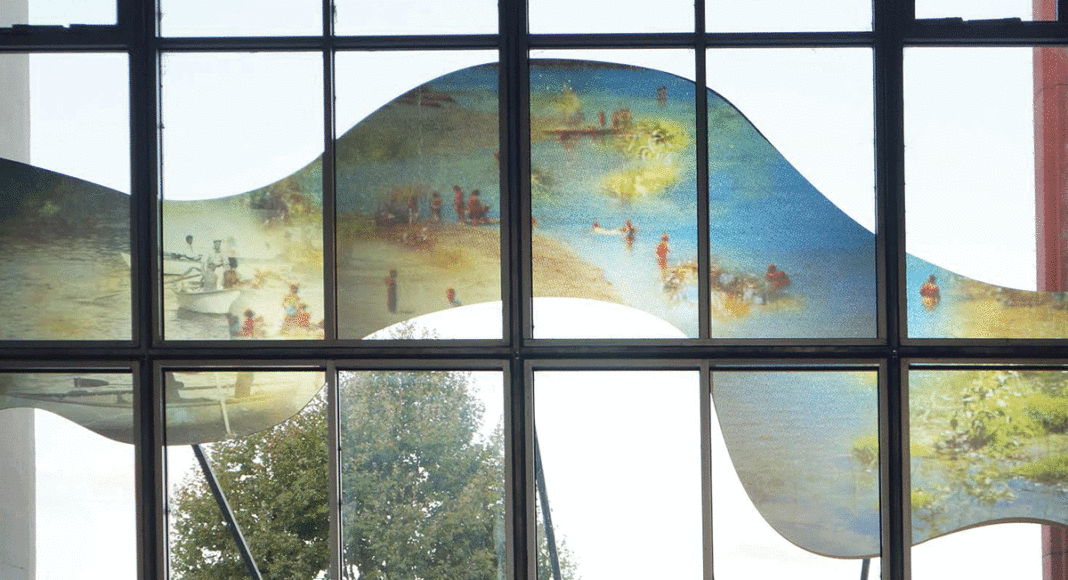The eye-catching digital installation currently undulating across the front windows of the Museum of Art & History (MAH) is the work of internationally-acclaimed MacArthur Fellow Camille Utterback. The flowing projection screen is a showcase for Utterback’s uncanny software design, Vital Current—Seeking the San Lorenzo, is a site-specific piece that will reward many views and many visits over the next 10 months.
“We are part of so many systems—the environment, our families, our communities—and everything that we do is embedded in all these other processes,” Utterback says. Tracking systems—of behavior, of natural processes, of human interaction—in visually compelling digitally-interactive artwork has won Utterback awards for the past 15 years.
“The original project began two years ago,” she explains, “when I was approached by MAH curator Justin Hoover. He had seen my San Jose airport project [Shifting Time, 2010], and so it began.”
A Creative Capital Fund grant Utterback received for the project required that she explore ways to use existing resources of the venue. “So I started looking around,” she says. “Historical archives were available at the Museum of Art & History, as well as at UCSC’s McHenry Library, so the idea was to use archival images and an interactive component that would activate the museum’s lobby.” Utterback’s past projects have used cameras to capture movement of people. “But in this case,” she laughs, “the MAH lobby is used in so many ways and is always changing, there was no way to make a camera piece. So the idea for a more intimate touch screen interface came up.”
A kiosk with a table-sized touch screen embedded with hidden software invites visitors to “touch” the river’s surface. And there were a few technical issues with the window and film at first, she admits. Three projectors suspended from the ceiling of the MAH lobby provide the succession of images—old, new, archival, historic—that appear on the special window screen as visitors move their hands over the kiosk touch screen. The full visual impact of Vital Currents is best seen at night. “We made a decision to make the window screen opaque so it would be visible through the windows from Abbott Square,” she says. “The overall concept was to create a visual, interactive metaphor for the ways in which our memories and the history of the river morph into each other in response to our present movements and touch.”
Rather than doing all of the programming herself, Utterback says, “for this piece I built the initial prototype using TouchDesigner and then hired an artist and designer to make it quickly. I wanted to show time fading in and out. The colors rippling into the water. I love that part. This is what you can do in programming, the surprise of it. I write the rules but can’t tell how it will specifically look.” Utterback was thrilled to see “even the smallest gesture magnified up on the wall.”
Raised in New England and trained as a painter, Utterback began programming in order to find “more relevant connections” with contemporary culture. “I went back to grad school at NYU in the interactive telecommunications program,” she says. “I didn’t intend to let go of art, but then it sort of evolved. I was in New York, I did an installation at a gallery—the right place at the right time. I moved out to San Francisco 10 years ago, and I’m now in my fourth year teaching at Stanford. I really love it here.”
“With Vital Current I hope something comes through about our engagement with that body of water. Hopefully it will start some conversation, about the river, its riches, its history, the trauma of flooding,” she says. “It’s so complex, the river is at once the site of a water carnival and also of a terrifying flood. The past is present in the present.”
Her point is “to make people think—to create an ongoing discussion.”
Utterback’s solo show at the Stanford Art Museum opens this week through March 26. In it, her digitally-generated installations continue to explore nuanced links between human and computer-generated systems. “How much can we control systems? How much does our interaction shape our experience of the past and the present?” she wonders. “What I really hope is that the MAH show will help people think about how all of our actions impact the world around us.”













